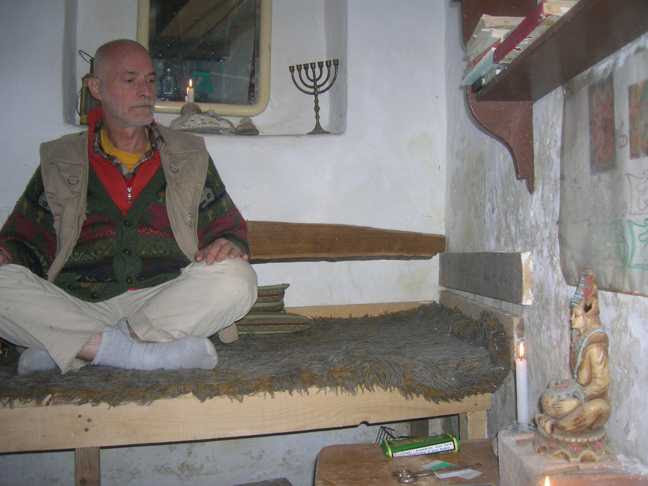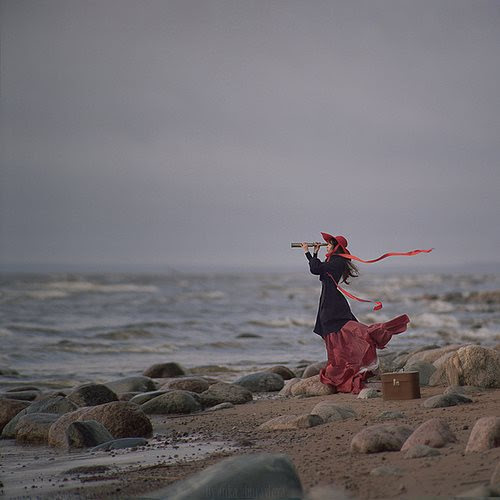Today I feel the need to further clarify, as far as possible, the discourse of the choice of destiny, of life and death of the body, of the meaning of the individual soul and of the absolute freedom of the Spirit.
At the basis of all I place my experience, implanted in memory, of the moment when consciousness was illuminating the formation of a body in my mother's womb, being this individual consciousness called "soul", in which I clearly perceived the karmic course that psychophysical form (that myself) was destined to fulfill. I saw his propensities, his genetic roots, innate tendencies, allotted destiny, difficulties, glory, sacrifice, in short, all that had to be accomplished through that specific human individual.
Well in perceiving all this clearly I felt a certain reluctance to face the trials, to witness them or to make them possible through the conscious presence that I am. Yet, the delineation of incipient destiny in the mirror of the mind, which recorded it and then stored it as a film that would later be projected in the course of life, involved a semblance of free will in accepting fate or rejecting it.
Certainly this feeling of acceptance or rejection was totally subjective and could not in any way modify the course of preordained events, but could leave a trace in the form of dissatisfaction and rejection, with the consequences you can imagine in the unfolding of the life that was about to manifest.
The sense of rebellion that would have led to such rejection would have perniciously delayed the fulfillment of the prefixed purpose of the soul itself ....
But, a moment, a concept needs to be clarified. What is the soul?
In Sanskrit it is called "Jivatman" which means individual soul, while the Absolute Self is called "Paramatman". You will have noticed that the suffix "Atman" remains in both terms, while only the prefix changes. From this we can understand the identity between the two expressions. The individual soul is therefore the "personal conscience" that illuminates the particular form not being different in its nature from the Universal Consciousness, which is also called Ishwara or God. At the same time this division into God, Soul and World is only functional to the manifestation, which takes place within the space-time, in reality there is only a pure and absolute non-dual awareness and devoid of any empiricism, being Unique and therefore not observable nor knowable. This awareness is the Spirit.
When this pure Consciousness is reflected in itself, as a spontaneous movement of its nature, the "I" rises. From this first illumination, the semblance "I am" is born (God is defined in the Bible "I Am That I am") and from the "I am" comes the identification "I am this" (ie the specific name and form) . From this process it follows a full observation and reflection of the variegated vital expressions (the creation and multiplicity of beings are put in place).
However, you will have realized that the undivided identity of the unique Being, the Spirit, does not lose its characteristics while being covered by a hypothetical separative illusion, useful for the purposes of the manifestation. In short, the pure and absolute non-dual "I" is always present, in an immanent and transcendent form, in everything and in every aspect of manifest consciousness. In brute matter it is latent ("in fieri") and in the universal and individual consciousness it is the illuminating aspect of awareness.
The fulfillment of the global destiny, inseparable from the whole, is present in the sum of all the possible (and impossible) frames of the infinite forms and names (which are born and die in continuation) and which are the variants of the tenfold aspect of illusion (the Creation itself). Being these ten aspects: consciousness and energy; the three qualities: harmony, motion, inertia; the five subtle and material elements (Ether, Air, Fire, Water, Earth).
It is necessary, however, to understand that all this description in progress belongs to the manifestative mode, therefore, it is part of a relative and dualistic knowledge. It can not therefore be considered spiritual "Knowledge", which is beyond any possible description being pure direct experience of the Self, but serves to satisfy the soul, or speculative mind, that feels the need for subtle reasoning in order to finally decide to submit to the Superior Power of the Self. Not that its submission is necessary to the reality already in place, in the sense that it becomes operational through a specific "choice" .... it would be better to say that this submission corresponds to the recognition of one's original identity and the renunciation of separative illusion.
In the apparent pattern that the soul makes towards the return home (from which it has never been removed except in the dualistic specular consideration) it crosses the infernal world of identity with the most dense ego and material forces, the human world of emotions and of the feelings and the heavenly world of the fulfillment of good and love. These are clearly intermediate stages, traps of the dual consciousness to keep the soul clinging to the separative illusion, part of the game that "imprisons" what can never be imprisoned. So the soul seems to have to choose through the experiences of life and conscience that await it as to bring this path to fulfillment.
And at this point I must also refer to the direct experience of the Self, which each of us can have at the right moment, in which we have full awareness of our original nature, of the eternally free Spirit's identity, and this experience is one of aspects that finally help the soul to give up its illusory separate identity. It corresponds to the moment in which the maturation of the soul is close to overcoming the infernal, worldly and religious bonds and manifests itself in the form of "Grace" of the inner master, of the Spirit who is the one and only truth.
And at this point every speech is silent...
Paolo D'Arpini
Testo Italiano
Oggi sento il bisogno di fare ulteriore chiarezza, per quanto possibile, sul discorso della scelta del destino, della vita e morte del corpo, del significato dell’anima individuale e della libertà assoluta dello Spirito.
Alla base di tutto pongo la mia esperienza, impiantata nella memoria, del momento in cui la coscienza stava illuminando la formazione di un corpo nel grembo di mia madre, essendo questa coscienza individuale denominata “anima”, in cui percepii chiaramente il decorso karmico che quella forma psicofisica (quel me stesso) era destinata a compiere. Vidi le sue propensioni, le sue radici geniche, le tendenze innate, le vicende destinate, le difficoltà, la gloria, il sacrificio, insomma tutto quel che doveva essere compiuto attraverso quello specifico individuo umano. Ebbene nel percepire tutto ciò chiaramente sentivo una certa riluttanza ad affrontare le prove, meglio dire a testimoniarle, o renderle possibili attraverso la presenza cosciente che io sono. Eppure, il delinearsi del destino incipiente nello specchio della mente, che lo registrava e quindi lo immagazzinava come una pellicola che poi sarebbe stata proiettata nel corso della vita, comportava una parvenza di libero arbitrio nell’accettare il fato o nel rifiutarlo.
Certo questa sensazione di accettazione o rifiuto era totalmente soggettiva e non poteva in alcun modo modificare il corso degli eventi preordinati, ma avrebbe potuto lasciare una traccia sotto forma di insoddisfazione e rifiuto, con le conseguenze che potete immaginare nel dispiegamento della vita che stava per manifestarsi.
Il senso di ribellione che avrebbe comportato tale rifiuto avrebbe perniciosamente ritardato il compimento dello scopo prefisso dell’anima stessa…. Ma, un momento, occorre chiarire un concetto. Cos’è l’anima?
In sanscrito essa viene chiamata “Jivatman” che significa anima individuale, mentre l’Assoluto viene chiamato “Paramatman”. Avrete notato che il suffisso “Atman” permane in entrambi i termini, mentre cambia solo il prefisso. Da ciò si intuisce l’identità fra le due espressioni. L’anima individuale quindi è la “coscienza personale” che illumina la particolare forma non essendo però diversa nella sua natura dalla Coscienza Universale, che viene definita anche Ishwara o Dio. Allo stesso tempo questa suddivisione in Dio, Anima e Mondo è solo funzionale alla manifestazione, che si svolge nell’ambito dello spazio-tempo, in realtà esiste solo una pura ed assoluta consapevolezza non duale e priva di ogni empiricità, essendo Unica e quindi non osservabile né conoscibile. Questa consapevolezza è lo Spirito.
Allorché questa pura Consapevolezza si riflette in se stessa, come moto spontaneo della sua natura, sorge l’ “Io”. Da questa prima illuminazione nasce poi la sembianza “Io sono” (Dio è definito nella Bibbia “I Am That I am”) e dall’”io sono” deriva l’identificazione “Io sono questo” (ovvero lo specifico nome e forma). Da questo processo ne consegue un’osservazione e riflessione a tutto campo delle variegate espressioni vitali (viene posta in atto la creazione e la molteplicità degli esseri).
Avrete però intuito che l’identità indivisa dell’Essere unico, lo Spirito, non perde le sue caratteristiche pur rivestendosi di un’ipotetica illusione separativa, utile ai fini della manifestazione. Insomma il puro ed assoluto “Io” non duale è sempre presente, in forma immanente e trascendente, in ogni cosa ed in ogni aspetto della coscienza manifesta. Nella materia bruta è latente (”in fieri”) e nella coscienza universale ed individuale è l’aspetto illuminante della consapevolezza.
Il compimento del destino globale, inscindibile dall’insieme, è presente nella summa di tutti i fotogrammi possibili (ed impossibili) delle infinite forme e nomi (che nascono e muoiono in continuazione) e che sono le varianti del decuplo aspetto dell’illusione (la Creazione stessa). Essendo questi dieci aspetti: coscienza ed energia; le tre qualità: armonia, moto, inerzia; i cinque elementi sottili e materiali (Etere, Aria, Fuoco, Acqua, Terra). Ma di questo ne abbiamo già parlato abbondantemente in altri articoli.
Occorre però capire che tutto questa descrizione in corso appartiene comunque al modo manifestativo, per cui rientra in una conoscenza relativa e dualistica. Non può essere perciò considerata “Conoscenza” spirituale, che è aldilà di ogni descrizione possibile essendo pura esperienza diretta del Sé, ma serve ad accontentare l’anima, o mente speculativa, che sente il bisogno di ragionamenti sottili per poter alfine decidere di sottomettersi al Potere Superiore del Sé. Non che la sua sottomissione sia necesaria alla realtà già in atto, nel senso che diviene operativa attraverso una specifica “scelta”…. meglio infatti sarebbe dire che tale sottomissione corrisponde al riconoscimento della propria identità originaria ed alla rinunzia dell’illusione separativa.
Nel percorso apparente che l’anima compie verso il ritorno a casa (dalla quale non si è mai allontanata se non nella considerazione speculare dualistica) essa attraversa il mondo infernale dell’identità con le forze egoiche e materiali più dense, il mondo umano delle emozioni e dei sentimenti ed il mondo paradisiaco del compimento del bene e dell’amore. Queste chiaramente sono tappe intermedie, trappole della coscienza duale per mantenere l’anima avvinghiata all’illusione separativa, parte del gioco che “imprigiona” ciò che mai può essere imprigionato. Per cui l’anima sembra dover scegliere attraverso le esperienze di vita e di coscienza che l’attendono come portare a compimento questo percorso.
Ed a questo punto debbo riferire anche dell’esperienza diretta del Sé, che ognuno di noi può avere nel momento opportuno, in cui si ha la piena consapevolezza della propria natura originaria, dell’identità nello Spirito eternamente libero, e tale esperienza è uno degli aspetti che aiutano infine l’anima a rinunciare alla sua illusoria identità separata. Corrisponde al momento in cui la maturazione dell’anima è vicina al superamento dei vincoli infernali, mondani e religiosi e si manifesta sotto forma di “Grazia” del maestro interiore, dello Spirito che è la sola ed unica verità. Ed a questo punto ogni discorso tace.
Paolo D’Arpini














